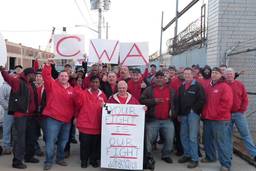Every week, In These Times rounds up some of the biggest labor stories that we missed in the week before. Feel free to send stories to mike@inthesetimes.com
The Huffington Post’s Katherine Fung reports that unionized New York Times staffers plan to walk out this afternoon. Workers have been without a contract for 18 months in a struggle with the company over proposed wage and benefit cuts. From the Huffington Post:
Staffers at the New York Times are planning to walk out on Monday afternoon, in protest of the management’s position on contract negotiations.
… On Monday, union members received an email from Grant Glickson, the unit chair for the Newspaper Guild of New York at the Times, with further instructions. Employees are set to meet at 3:35 p.m., according to the email, and leave the office “for a few minutes.”
… The walkout won’t be the first protest that Times staffers have staged over proposed contract terms. Earlier this year, employees held a silent protest outside a meeting of top editors, and demonstrated outside the company’s annual shareholders meeting. Angry staffers also made their demands heard in a series of videos.
Contract talks started up again in September after a hiatus, but the newspaper’s call to freeze pension plans and write separate contracts for print and digital employees continues to pose roadblocks in the negotiations.
A South African National Union of Mineworkers spokesperson tells Reuters that the branch leader of its union at the Lonmin mine was shot “execution style” on Friday. No further details are available.
In August, Lonmin was the site of the killings of 34 striking miners by South African police. Now, more than 75,000 miners on strike throughout the country, and one major mine group may have escalated the situation even more by firing 12,000 striking workers. From Reuters:
The sackings at Amplats (Anglo American Platinum) on Friday triggered a sharp fall in South Africa’s rand as investors dumped the country’s assets. … Strikes have spread beyond the mining sector, with Shell saying on Friday it would not be able to honor contracts to deliver fuel near Johannesburg because of a trucking strike.
The unrest is causing political trouble for President Jacob Zuma and his ruling African National Congress (ANC), the veteran liberation movement with long-standing ties to labor unions.
“You fire 12,000 people, and it’s like ‘Oh my god, what happens now?’” one Johannesburg-based currency strategist said.
According to Bureau of Labor Statistics job numbers released Friday, unemployment has fallen below 8 percent for the first time since January of 2009. However, while unemployment may have decreased, so has job quality, reports the Huffington Post’s Dave Jamieson:
Economists have found plenty of encouraging signs in Friday’s jobs report, in which the unemployment rate dropped from 8.1 to 7.8 percent, but they aren’t celebrating the number of American workers who are still stuck with part-time hours.
The number of workers classified as “part time for economic reasons” – that is, not by choice – rose last month by nearly 500,000, to a total of 8.6 million when seasonally adjusted, according to the Bureau of Labor Statistics.
Such a month-to-month fluctuation should be kept in perspective given the relatively small sample size, but the stubbornly high number of unwilling part-timers underscores one lingering problem of the economic recovery: even though they’re better off than the jobless, too many of the employed aren’t as employed as they’d like to be.
“In this otherwise quite rosy household survey, this is an extremely elevated number,” Heidi Shierholz, an economist at the Economic Policy Institute, said of the part-timers. “A lot of people, if they found work, they’re not getting the hours that they need.”
An expose by The New Republic’s Alec MacGillis finds evidence that a major Romney donor has been forcing his coal-company employees to give to the political campaigns of top Republicans, including Romney. From The New Republic:
Over the years, [coal company] CEO Robert Murray has brought in GOP pols from as far away as Alaska, California, and Massachusetts for fund-raisers. In 2010, the year John Boehner became House speaker, the firm’s 3,000 employees and their families were his second-biggest source of funds. (AT&T was in first place, but it has nearly 200,000 employees.) This year, Murray is one of the most important GOP players in one of the most important battleground states in the country. In May, he hosted a $1.7 million fund-raiser for Romney. Employees have given the nominee more than $120,000. In August, Romney used Murray’s Century Mine in the town of Beallsville for a speech attacking Barack Obama as anti-coal. This fall, scenes from that event — several dozen coal-smudged Murray miners standing behind the candidate in a tableau framed by a giant American flag and a COAL COUNTRY STANDS WITH MITT placard — have shown up in a Romney ad.
The ads aired even after Ohio papers reported what I was told by several miners at the event, a bit of news that an internal memo confirms: The crowd was not there of its own accord. Murray had suspended Century’s operations and made clear to workers that they were expected to attend, without pay. “I tell ya, you’ve got a great boss,” Romney said in acknowledging Robert Murray from the stage. “He runs a great operation here.”
The accounts of two sources who have worked in managerial positions at the firm, and a review of letters and memos to Murray employees, suggest that coercion may also explain Murray staffers’ financial support for Romney. Murray, it turns out, has for years pressured salaried employees to give to the Murray Energy political action committee (PAC) and to Republican candidates chosen by the company. Internal documents show that company officials track who is and is not giving. The sources say that those who do not give are at risk of being demoted or missing out on bonuses, claims Murray denies.
The Murray sources, who requested anonymity for fear of retribution, came forward separately. But they painted similar pictures of the fund-raising operation. “There’s a lot of coercion,” says one of them. “I just wanted to work, but you feel this constant pressure that, if you don’t contribute, your job’s at stake. You’re compelled to do this whether you want to or not.” Says the second: “They will give you a call if you’re not giving. . . . It’s expected you give Mr. Murray what he asks for.”
Was there a connection between rank-and-file wildcat strikes in the 1970s and country musician’ resistance to the mainstreaming of their genre? From the The New Inquiry:
By stressing the historical simultaneity of the ACE and the rank-and-file revolt of the 1970s, I don’t mean to suggest the country stars explicitly understood their struggle as labor activism. But if we can still believe in such a thing as the zeitgeist, it is clear that the two phenomena were different manifestations of the same impulse. Both stories, lost to historical amnesia, seem completely foreign today, examples of faded defiance among so-called middle Americans. Each narrative also belie liberal perceptions of country music and the white working class as incorrigibly conservative. (One need only look at the New York Times’s man-bites-dog shock at encountering “irate longhairs, not on college campuses, but among blue collar workers” to see what I mean.) Through ignorance of working class culture, and outright snobbery, many upper-middle class Americans understand blue collar and red flag as mutually exclusive loyalties. The hollowness of this judgment is shown by the history of working class struggles in the 1970s.
An illegal strike of water workers in Detroit has ended after the Detroit Water and Sewerage Department agreed to rehire 34 workers fired over the action. From MLive.com:
After a couple of false ends to the strike this week, Detroit’s water and sewage workers union has now announced that picketing will stop and all employees will return to work.
AFSCME Local 207 officials said they’ve reached an agreement with the city’s water department that will allow a return to the bargaining table and the reinstatement of 34 workers who were set to be fired for starting the strike.
… Workers from the Detroit Wastewater Treatment Plant walked out and began picketing Sunday, protesting a planned 81 percent reduction in the department.
The Detroit Water and Sewerage Department on Tuesday announced the suspension of 34 workers pending termination, saying the striking employees “endangered public health and safety by unlawfully abandoning their jobs at the plant.”
The striking workers defiantly continued to picket outside the plant even after a federal court order to return to work and rejecting appeals from another union entity, AFSCME Council 25, to obey the judge’s order.









